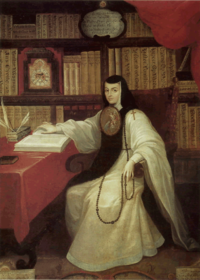
Sor Juana Ines de la Cruz: just trust me, she was a 17th century badass
Like many other college freshmen across the country, I enrolled in a prerequisite, required English class for my first semester of school. Unlike most other college freshmen, though, I wasn’t stuck reading the immortal words of old, dead White dudes. Instead, I enrolled in a course called “Women and Culture” which was, predictably, all about female writers and female-centric works.
Yeah, I know – a feminist blogger at a women’s college enrolled in “Women and Culture.” I am a walking, talking feminist stereotype. But in actuality, my thought process behind choosing that course over courses that focused on the literature of South America or the Mediterranean (my other choices) wasn’t exactly rooted in my feminist identity (at least not at face value). It was more that when I really thought about the English courses I’d taken in high school, I realized that I’d barely read the work of any female authors. I read Mrs. Dalloway in my AP Lit course and a few short stories and/or poems by women over the years as part of a larger unit, but that was pretty much it. I realized that my education had mostly been founded on the words and ideas of men. I figured it was about time that I did something about that.
And I’m really glad I did. Thanks to this course, I was introduced to an impressive list of women, most of whom I had never even heard of before, some dating back as long ago as China’s Tang Dynasty and Japan’s Heian period. I read the beautiful poems of Sor Juana and the Lais of Marie de France. I read the plays of Aphra Behn and The Pillow Book of Sei Shonagon. The list goes on. As my professor described the experience of first reading these women, every time I finished one of these works I had to ask: “Where have you been all of my life?”
But interestingly enough, along with the joy that came with reading the works of women – and not just women, but women who broke some incredible barriers by writing hundreds of years ago – came frustration. These women wrote of the type of sexism and double standards that, though they’re clearly not as bad today, are still very much present. That was the central paradox of reading these women writers: it was both astounding and inspiring that their work was still so relevant, but in some ways that relevance was beyond upsetting.
Despite this, though, I highly recommend that everybody read the works of these women and/or other women writers. I always thought that I was just the kind of person who didn’t get non-contemporary literature, that I just couldn’t connect to it on a deeper level. It turned out that that wasn’t true – it’s just that I couldn’t relate to the authors I had been reading. I mean, sure, there are some people who venerate Milton and Charles Dickens and the like. And that’s cool. But if it’s okay with everybody I’m going to go ahead and start an unofficial fan club for Sor Juana, Aphra Behn and all the women who came before and after them. And you’re more than welcome to join me.

